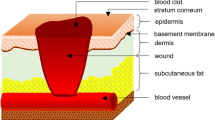Summary
The collagen gel contraction (CGC) assay is used frequently to study the cell-mediated reorganization of the extracellular matrix. In a typical CGC assay, cells embedded in a disk-shaped lattice (gel) of native type I collagen fibers compress the fibers and, consequently, reduce the diameter of the collagen disk within h or d. The degree to which the collagen is contracted is usually quantified by measurement of the diameter or the area of the disk. During CGC assays, friction or adhesion (or both) between gels and their culture containers can cause gels to be incompletely contracted or to acquire distorted shapes. Such occurrences degrade the reproducibility and reliability of measurements of gel dimensions. To address these problems, we developed an oil-supported collagen retraction (OSCR) assay that creates an environment of low friction and adhesion around the contracting collagen gel. The OSCR assay is accomplished with simple equipment and is easily performed, sensitive, and consistently yields fully contracted gels with minimal distortion.
Similar content being viewed by others
References
Bell, E.; Ivarsson, B.; Merrill, C. Production of a tissue-like structure by contraction of collagen lattices by human fibroblasts of different proliferative potential in vitro. Proc. Natl. Acad. Sci. USA 76:1274–1278; 1979.
Bittner, K.; Liszio, C.; Blumberg, P.; Schönherr, E.; Kresse, H. Modulation of collagen gel contraction by decorin. Biochem. J. 314:159–166; 1996.
Burgess, M. L.; Carver, W. E.; Terracio, L.; Wilson, S. P.; Wilson, M. A.; Borg, T. K. Integrin-mediated collagen gel contraction by cardiac fibroblasts. Effects of angiotensin II. Circ. Res. 74:291–298; 1994.
Carver, W.; Molano, I.; Reaves, T. A.; Borg, T. K.; Terracio, L. Role of the α1β1 integrin complex in collagen gel contraction in vitro by fibroblasts. J. Cell. Physiol. 165:425–437; 1995.
Clark, R. A. F.; Folkvord, J. M.; Hart, C. E.; Murray, M. J.; McPherson, J. M. Platelet isoforms of platelet-derived growth factor stimulate fibroblasts to contract collagen matrices. J. Clin. Invest. 84:1036–1040; 1989.
Cooke, M. F.; Sakai, T.; Mosher, D. F. Contraction of collagen matrices mediated by alpha2beta1A and alpha(v)beta3 integrins. J. Cell Sci. 113:2375–2383; 2000.
Davis, G. E.; Camarillo, C. W. Regulation of endothelial cell morphogenesis by integrins, mechanical forces and matrix guidance pathways. Exp. Cell Res. 216:113–123; 1995.
Davis, G. E.; Pintar Allen, K. A.; Salazar, R.; Maxwell, S. A. Matrix metalloproteinase-1 and-9 activation by plasmin regulates a novel endothelial cell-mediated mechanism of collagen gel contraction and capillary tube regression in three-dimensional collagen matrices. J. Cell Sci. 114:917–930; 2001.
Deryugina, E. I.; Bourdon, M. A.; Reisfeld, R. A.; Strongin, A. Remodeling of collagen matrix by human tumor cells requires activation and cell surface association of matrix metalloproteinase-2. Cancer Res. 58:3743–3750; 1998.
Guidry, C.; Hook, M. Endothelins produced by endothelial cells promote collagen gel contraction by fibroblasts. J. Cell Biol. 115:873–880; 1991.
Gullberg, D.; Tingström, A.; Thuresson, A.-C.; Olsson, L.; Terracio, L.; Borg, T. K.; Rubin, K. β1 integrin-mediated collagen gel contraction is stimulated by PDGF. Exp. Cell Res. 186:264–272; 1990.
Harris, A. K.; Stopak, D.; Wild, P. Fibroblast traction as a mechanism for collagen morphogenesis. Nature 290:249–251; 1981.
Kanekar, S.; Borg, T. K.; Terracio, L.; Carver, W. Modulation of heart fibroblast migration and collagen gel contraction by IGF-I. Cell Adhes. Commun. 7:513–523; 2000.
Kitamura, M.; Maruyama, N.; Yoshida, H.; Nagasawa, R.; Mitarai, T.; Sakai, O. Extracellular matrix contraction by cultured mesangial cells: an assay system for mesangial cell-matrix interaction. Exp. Mol. Pathol. 54:181–200; 1991.
Klein, C. E.; Dressel, D.; Steinmayer, T.; Mauch, C.; Eckes, B.; Krieg, T.; Bankert, R. B.; Weber, L. Integrin α2β1 is upregulated in fibroblasts and highly aggressive melanoma cells in three-dimensional collagen lattices and mediates the reorganization of collagen I fibrils. J. Cell Biol. 115:1427–1436; 1991.
Montesano, R.; Orci, L. Transforming growth factor β stimulates collagen-matrix contraction by fibroblasts: implications for wound healing. Proc. Natl. Acad. Sci. USA 85:4894–4897; 1988.
Reed, M. J.; Vernon, R. B.; Abrass, I. B.; Sage, E. H. TGF-β1 induces the expression of type I collagen and SPARC, and enhances contraction of collagen gels, by fibroblasts from young and aged donors. J. Cell. Physiol. 158:169–179; 1994.
Smith-Thomas, L. C.; Richardson, P. S.; Rennie, I. G.; Palmer, I.; Boulton, M.; Sheridan, C.; MacNeil, S. Influence of pigment content, intracellular calcium and cyclic AMP on the ability of human retinal pigment epithelial cells to contract collagen gels. Curr. Eye Res. 21:518–529; 2000.
Travis, J. A.; Hughes, M. G.; Wong, J. M.; Wagner, W. D.; Geary, R. L. Hyaluronan enhances contraction of collagen by smooth muscle cells and adventitial fibroblasts: role of CD44 and implications for constritive remodeling. Circ. Res. 88:2–4; 2001.
Vernon, R. B.; Angello, J. C.; Iruela-Arispe, M. L.; Lane, T. F.; Sage, E. H. Reorganization of basement membrane matrices by cellular traction promotes the formation of cellular networks in vitro. Lab. Invest. 66:536–547; 1992.
Vernon, R. B.; Lara, S. L.; Drake, C. J.; Iruela-Arispe, M. L.; Angello, J. C.; Little, C. D.; Wight, T. N.; Sage, E. H. Organized type I collagen infleunces endothelial patterns during “spontaneous angiogenesis in vitro”: planar cultures as models of vascular development. In Vitro Cell. Dev. Biol. 31:120–131; 1995.
Vernon, R. B.; Sage, E. H. Contraction of fibrillar type I collagen by endothelial cells: a study in vitro. J. Cell. Biochem. 60:185–197; 1996.
Wen, F. Q.; Skold, C. M.; Liu, X. D.; Ertl, R. F.; Zhu, Y. K.; Kohyama, T.; Wang, H.; Rennard, S. I. Glucocorticoids and TGF-beta 1 synergize in augmenting fibroblast mediated contraction of collagen gels. Inflammation 25:109–117; 2001.
Author information
Authors and Affiliations
Corresponding author
Rights and permissions
About this article
Cite this article
Vernon, R.B., Gooden, M.D. An improved method for the collagen gel contraction assay. In Vitro Cell.Dev.Biol.-Animal 38, 97–101 (2002). https://doi.org/10.1290/1071-2690(2002)038<0097:AIMFTC>2.0.CO;2
Received:
Accepted:
Issue Date:
DOI: https://doi.org/10.1290/1071-2690(2002)038<0097:AIMFTC>2.0.CO;2




